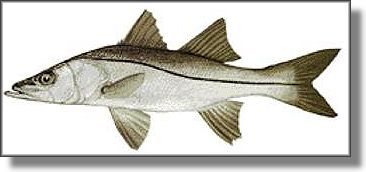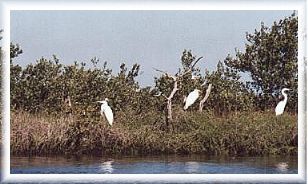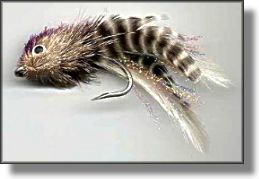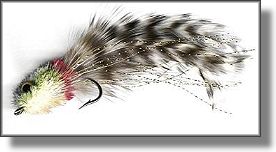
Snook are a premier, game fish, faster than a speeding bullet, able to leap tall mangrove
roots in a single bound. Well, maybe not faster than a bullet, but Snook can certainly
jump and then pull like anchors into the mangroves.
Snook (Centropomus Undecimalis) are known also as 'Robalo' or 'Old
Linesides.' If ever a state has a fishing mystique, it would be that inspired by the common
snook in Florida. Snook fishermen are addicted to the allure and pursue snook with
missionary zeal, whether by drifting live bait on the outgoing tide near a bridge abutment,
jetty or trying to deceive your them by casting a favorite fly into the shallows of the
overhanging mangroves.
In the world of game-fish, the snook is always a gentleman and a prize that ignites an
adrenaline rush with a starting explosion at the surface. His aerobatic display announces
a hook-up. Snook are the premier fly fishing anglers dream, and Snook are found on
both shores of the Americas with concentrations in Florida, Texas, and Southern California.
Running from 5 to 50 pounds, they prefer the warm temperate waters of the Atlantic and
Pacific coastal areas with water temperatures of 70-86° F. Snook have sharp secondary
gill plates, necessitating 50# or 40# wire shock leaders. Do not try to lift a Snook from
the water by reaching your fingers under these plates as is done with freshwater and striped bass.
All Snook are known for their strength and palatability. Along with Dorado (Mai Mai) and
Redfish (Red Drum or Channel Bass) they are a gourmet white-meat staple of many
nations. Small-time commercials usually take them with gillnets.
Snook, like a number of species, need fresh water. In Florida, the Snook population
is being curbed by the diversion of fresh water before it reaches the Everglades or
Mangrove estuaries along the coastal waterways. The Snook is a great game-fish,
worthy of good management, a phrase that has a hollow ring. Snook love to ambush
baitfish from tall saltwater grasses at water's edge. The perfect habitat is one where
there is fast flowing water either at creek drop offs, mangrove roots, or around dock
pilings. Outgoing tides provide the best situations for snook because they will attack
baitfish being pulled out by the tide. Be aware of water levels so you don't get
trapped on a falling tide.

Taking Snook on a fly is a real challenge, it's not that they won't hit. They will, but
they're difficult to control and break tippets in mangrove roots and other underwater
obstructions. There is nothing that equals the quick water pushing, smashing attack
on a fly by a snook. Snook will come at high speed out of the mangroves or a grass
line and pounce on it. The same flies that take stripers will interest Snook, from
bushy deer-hair sliders to sinking versions.
Smaller snook, found along the canals and fingers of the Everglades, will take appropriate
sized flies tied on #1/0 to 2/0 O'Shaughnessy hooks. For most saltwater fly-fishing, this
style is the ideal hook. It's an old bend, going back to the early 1800s when
Robert O'Shaughnessy of Limerick, Ireland, first produced it.
Colors should match natural baitfish-- small mullet, cigar minnows, silversides-- or local
shrimp. The best flies will push a lot of water, hair bug patterns is yellow, white, green,
silver, and brown, all with a touch of red. My all time favorite snook fly (Beach Bunny
shown below, left) also works well on Sea Trout, Baby Poon and Strippers.
 Another really great fly is the Tomoka Mullet ( shown below, right) tied by
Ken Bay, a personal friend, fly-tying mentor and author of Salt Water Flies [1972].
Another really great fly is the Tomoka Mullet ( shown below, right) tied by
Ken Bay, a personal friend, fly-tying mentor and author of Salt Water Flies [1972].
Obviously, this fly has been used a few times, and has caught a lot of snook. When
you return home from your fishing trip, wash your flies in mild soapy fresh water.
 This will rejuvenate and preserve the fly, and it will last until the next snook decides
to devour it. Most fish caught on fly don't devour hooks. If you use barbless hooks
you'll find the hook is easier to remove, making catch and release a breeze.
This will rejuvenate and preserve the fly, and it will last until the next snook decides
to devour it. Most fish caught on fly don't devour hooks. If you use barbless hooks
you'll find the hook is easier to remove, making catch and release a breeze.
A fly rod is the perfect tool for working a mangrove line, because you can make
repeated delivery to the strike zone very quick and accurately. One retrieve and
40-foot cast puts you right back to the spot where you saw the movement. If you
keep the boat at the right angle and distance every cast can put the fly in the same
location next to mangrove roots or grass line. The trick to hookups of snook, like
tarpon, is to clear the loose line immediately after the hit comes and the hook is set.
Since the fly is set softly the snook is free to strut his stuff. The long fly rod allows
you to work the fish and dodge the roots or obstructions.
Ideal times for snook fishing are out going tides, late afternoon or very early mornings.
Fly-fishing for snook is, in my opinion, better than Tarpon fishing and parallels the action
of jacks, my other favorite game fish. Take an ultra hair bug and work the edges
with short, snappy strips. Allow the fly to push some water.
Until next time ~ Doug
About Doug:
Capt. Doug Sinclair has relocated from New Smyrna Beach, Florida to
Grantsboro, NC. He specializes in fly-fishing and light tackle charters.
Doug charters the Coastal Carolina area of New Bern or Oriental.
Catch him on the web at
www.flyfishacademy.net or call him at (252) 745-3500.
Doug is also a Sponsor here on FAOL.
|




 Another really great fly is the Tomoka Mullet ( shown below, right) tied by
Ken Bay, a personal friend, fly-tying mentor and author of Salt Water Flies [1972].
Another really great fly is the Tomoka Mullet ( shown below, right) tied by
Ken Bay, a personal friend, fly-tying mentor and author of Salt Water Flies [1972]. This will rejuvenate and preserve the fly, and it will last until the next snook decides
to devour it. Most fish caught on fly don't devour hooks. If you use barbless hooks
you'll find the hook is easier to remove, making catch and release a breeze.
This will rejuvenate and preserve the fly, and it will last until the next snook decides
to devour it. Most fish caught on fly don't devour hooks. If you use barbless hooks
you'll find the hook is easier to remove, making catch and release a breeze.